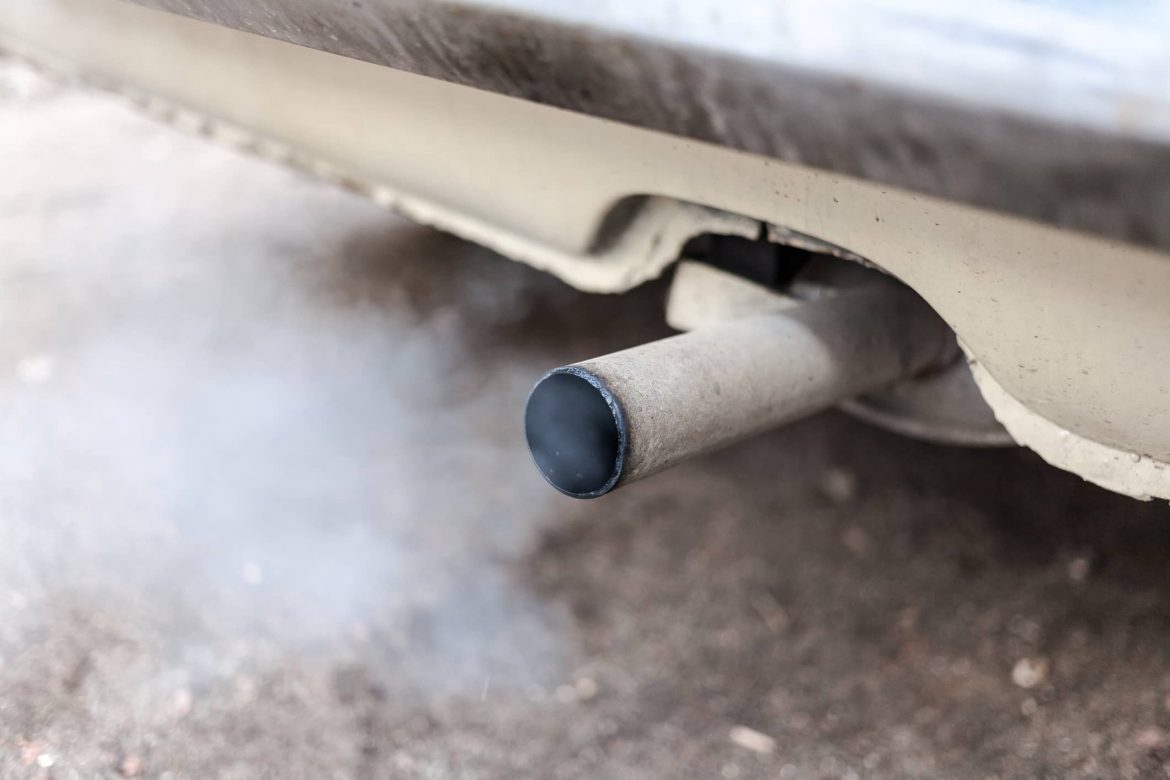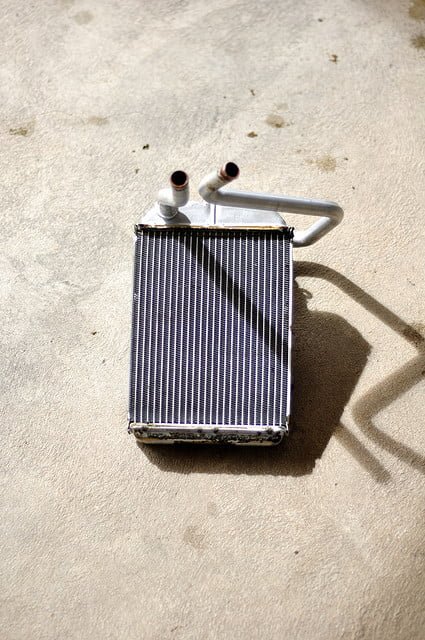Everything is going along great with your car, then you notice white smoke is coming out of your exhaust pipe. And not just big clouds of tissue-thin white wisps that billow out of the pipe when you start your car on cold days. That’s nothing more than condensation being heated into water vapor in cold weather. You can tell that is the case when the white smoke dissipates in a minute or two once the vehicle is warmed up.
No, you are seeing thick white-gray cotton balls of smoke. They might even smell sweet or look bluish-white, and they don’t peter out once you get going. If your exhaust smoke is white like that, should you worry?
Unfortunately, yes.
White smoke exhaust is a signal from your vehicle that something is wrong and needs your immediate attention. There are several issues that can cause white smoke to exit your exhaust pipe, and none of them are particularly good.
White Exhaust Smoke Caused by an Oil Leak
The most common reason for white smoke exhaust is leaking motor oil, usually out of your piston o-rings or valve seals. The oil seeps into the combustion chamber, where it is burned and blown out through the tailpipe. This can take the form of blue smoke too, depending on the mix of oil and fuel.
This isn’t a great sign on a few different levels. Oil does not belong in the combustion chamber and will gunk up the spark plugs and reduce the efficiency and smooth operation of the engine. Eventually, it could cause intermittent starting and engine misfiring. As the oil leaks and burns off, there is also less of it to complete the critical job of lubricating the engine’s moving parts. Eventually, oil levels will drop and constitute a hazard to the engine.
In other words, white exhaust smoke or blue exhaust smoke from an oil leak is a warning to check the oil and fix the leak. A secondary solution if you aren’t able to do a hard part repair, is to pour half of a bottle of BlueDevil Stop Smoke Engine Repair into the crankcase. After about 100 miles of driving, this product can seal leaking components throughout the fluid oil system to stop exhaust smoke and reduce oil loss permanently.
To use BlueDevil Stop Smoke & Engine Repair, turn off the engine and add half of the bottle. Drive the car around and let its specially formulated additive revitalize worn and damaged seals. Add the other half of the bottle after the next oil and filter change.
White Exhaust Smoke Caused by Leaking Coolant
Coolant is pumped around the engine to absorb its heat and distribute it through the radiator. A leak anywhere in the cooling system, such as in the reservoir tank, the coolant lines or, most commonly, at the o-rings and seals, can cause coolant to seep into the combustion chamber and get burned off with the fuel as white exhaust smoke. When coolant is part of white smoke from the exhaust pipe, it will also smell sweet.
White exhaust smoke caused by leaking coolant may also be a sign of a blown head gasket. This is a major problem that can cost more than $1000 to repair.
As with motor oil, the presence of coolant in the combustion chamber is a problem on multiple levels. First, it wastes coolant, which has the important job of keeping the engine from overheating. Leaking coolant means there is less coolant and more stress on the water pump, and ultimately less cooling of the engine. Operating the vehicle for too long with a coolant leak will lead to the engine overheating and stranding you on the side of the road. It can also damage the engine.
The other problem with leaking coolant is it pollutes the combustion process, just like oil does. Coolant entering the engine can foul spark plugs and make the engine run less efficiently.
It is possible to verify the problem by checking the coolant level in the reservoir, which is a translucent plastic jug marked with minimum and maximum levels for easy diagnosis. If the coolant level is between them, check it again after more driving and note whether the level has dropped further. If the level is below the minimum line, add coolant and get the leak fixed.
If the problem leading to white exhaust smoke is leaking coolant, which you have confirmed by noting a drop in coolant level or by smelling sweet exhaust fumes, it must be addressed. While a hard part repair is always best, another option is to pour a bottle of BlueDevil Head Gasket Repair into the radiator when the engine is cold. That will provide a permanent repair by bonding to various materials such as metal, aluminum, cast, alloy, or plastic. The product is safe for all vehicles and mixes with antifreeze.
Before pouring the product in, make sure the engine is cold. Start the engine, run the heat on full blast, and pour the contents into the radiator slowly. Make sure there is room in the radiator; if there isn’t, drain 16 ounces to accommodate the product.
If the problem is something other than a seal, it must be diagnosed and fixed. It might need a new reservoir tank, coolant hose, or head gasket.
White Exhaust Smoke Caused by Bad Fuel Injectors
Fuel injectors are modern inventions designed to make your car run more efficiently. They determine the exact moment to deliver fuel into the combustion chamber for optimum efficiency and gas mileage. When the fuel injector, or fuel pressure regulator, is faulty, the engine will receive the wrong fuel-air mixture at the moment of combustion. Too much fuel means some will escape without being burned off. Not enough fuel causes misfiring and a rough-running vehicle. In either case, fuel is burned off as part of the exhaust process, coloring the exhaust smoke white.
A bad fuel injector can be fixed by replacing it with a new one. This is a process that requires a couple of hours, a moderate amount of expertise, a disconnected battery and removal of the fuel rail, which houses the injectors, from the intake manifold. Before installing new injectors, dip their tips in engine oil to create a more perfect seal.
White Exhaust Smoke Caused by a Bad Engine Control Unit
When the engine control unit is glitchy, it throws off the fuel injectors and creates the white exhaust smoke situation. Engine control unit is a fancy way of saying the engine’s computer, which simply needs to be reprogrammed. Sometimes all it takes is disconnecting the battery for a minute to reset the computer. If that fails, the vehicle needs to be seen by a car care professional with the equipment required to diagnose and fix it.
White Exhaust Smoke Caused by Unknown Reasons
These are just the most common culprits leading to white smoke from the tailpipe, but there are plenty of others. And unless the white smoke smells sweet, it’s difficult to distinguish one cause from another. If checking oil and coolant levels suggest a leak, pouring in a bottle of chemical additive can often cure the problem, but it is always wise to take the vehicle to a service station where professionals with the proper tools and diagnostic equipment can identify the issue and repair it.
What About Blue Exhaust Smoke?
Whitish-blue smoke indicates your car is burning oil. Because it can lead to so many other problems, not the least of which is the engine seizing up, the oil leak should be addressed immediately, as noted above.
What About Black Exhaust Smoke?
Black plumes of smoke from the tailpipe tell a different story, but still one that demands attention. Black smoke is a clear sign you’re burning too much fuel. You might also see the problem as grey smoke exhaust.
The easiest-to-fix perpetrator is the air filter, because a clogged filter reduces the air flow and leads to excess fuel being burned. An air filter can be checked in 10 seconds and replaced in 20. A new air filter costs $20-$50 and is definitely the most DIY repair this side of refueling. Checking and changing the air filter yourself will save you $30-$50 in mechanic’s fees.
If the air filter is clean, the problem is likely in the fuel injectors or cylinder chambers, which is less of a DIY project.
The bottom line is the fumes coming from your tailpipe should be clear if the vehicle is running right. Anytime you see colored exhaust smoke of any kind, other than on a cold morning when you first start your engine, it is cause for concern and immediate action. It is better to spend some time and money fixing a small problem than paying thousands to rebuild an engine that has overheated or seized up.
BlueDevil Products can be found at AutoZone, Advance Auto Parts, O’Reilly Auto Parts, NAPA, Parts Authority, Auto Value, Bumper to Bumper and other major auto parts retailers.
BlueDevil Products can be found on Amazon.com or at AutoZone, Advance Auto Parts, O’Reilly Auto Parts, NAPA, and other major auto parts retailers.
2 responses to "Why Is My Exhaust Smoke White?"
2 Comments
Leave a Reply
Related Articles
Search Blog
Subscribe
Blog Categories




I put Blue devil head gasket sealant in my vehicle yesterday morning is the next day and the vehicle is running much better not overheating but I still have white smoke steam and water dripping out of my exhaust how long does it take for Blue devil head gasket sealant to work I’m starting to get very concerned please help thank you
Harold-
Please keep in mind that the exhaust system can produce smoke for several hours before it can completely clear itself out, so that is a symptom that may not go away right away. You can run the vehicle intermittently over the course of the next few days. Either let it sit and idle or you can take it on short trips around the block. The smoke/steam should eventually dissipate.
Thank you!
-BDP